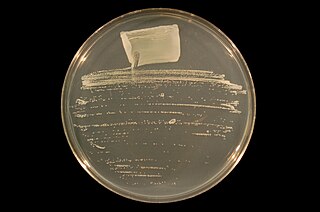
Listeria is a genus of bacteria that acts as an intracellular parasite in mammals. By 2024, 28 species had been identified. The genus is named in honour of the British pioneer of sterile surgery Joseph Lister. Listeria species are Gram-positive, rod-shaped, and facultatively anaerobic, and do not produce endospores.

Thermus is a genus of thermophilic bacteria. It is one of several bacteria belonging to the Deinococcota phylum. According to comparative analysis of 16S rRNA, this is one the most ancient group of bacteria Thermus species can be distinguished from other genera in the family Thermaceae as well as all other bacteria by the presence of eight conserved signature indels found in proteins such as adenylate kinase and replicative DNA helicase as well as 14 conserved signature proteins that are exclusively shared by members of this genus.

Halomonadaceae is a family of halophilic Pseudomonadota.
Alteromonas is a genus of Pseudomonadota found in sea water, either in the open ocean or in the coast. It is Gram-negative. Its cells are curved rods with a single polar flagellum.

Ensifer is a genus of nitrogen-fixing bacteria (rhizobia), three of which have been sequenced.
Cedecea is a genus of extremely rare bacteria of the family Enterobacteriaceae. The name of this genus was derived from CDC, the abbreviation for the Centers for Disease Control where the initial members of this genus were discovered. This genus resembles no other group of Enterobacteriaceae. Cedecea bacteria are Gram-negative, bacillus in shape, motile, nonencapsulated, and non-spore-forming. The strains of Cedecea appear to be similar to those of Serratia. Both Cedecea and Serratia are lipase positive and resistant to colistin and cephalothin; however, Cedecea is unable to hydrolyze gelatin or DNA.
Dactylosporangium is a genus of bacteria in the phylum Actinomycetota.
Listeria ivanovii is a species of bacteria in the genus Listeria. The listeria are rod-shaped bacteria, do not produce spores, and become positively stained when subjected to Gram staining. Of the six bacteria species within the genus, L. ivanovii is one of the two pathogenic species. In 1955 Bulgaria, the first known isolation of this species was found from sheep. It behaves like L. monocytogenes, but is found almost exclusively in ruminants. The species is named in honor of Bulgarian microbiologist Ivan Ivanov. This species is facultatively anaerobic, which makes it possible for it to go through fermentation when there is oxygen depletion.
Acinetobacter junii is a species of bacteria. Its type strain is ATCC 17908. It can be pathogenic. This bacterium has been linked to nosocomial infections including catheter-related blood stream infections and cellulitis.
Citrobacter youngae is a Gram-negative species of bacteria.
Listeria rocourtiae is a species of bacteria. It is a Gram-positive, facultatively anaerobic, motile, non-spore-forming bacillus. It is non-pathongenic and non-hemolytic. The species was first isolated from pre-cut lettuce in Salzburg, Austria in 2002. It is named in honor of Jocelyne Rocourt, "whose work had a major impact on the taxonomy of the genus Listeria."
Streptomyces cellulolyticus is a cellulolytic bacterium species from the genus of Streptomyces.
Streptomyces sulfonofaciens is a bacterium species from the genus of Streptomyces which has been isolated from soil in Nachikatsuura from the Wakayama Prefecture in Japan. Streptomyces sulfonofaciens produces the antibiotic pluracidomycin.
Listeria welshimeri is a species of bacteria. It is a Gram-positive, facultatively anaerobic, motile, non-spore-forming bacillus. It is non-pathogenic and non-hemolytic. It was isolated from decayed vegetation in the United States by H. J. Welshimer, after whom the species is named. The species was first proposed in 1983.
Listeria grayi is a species of bacteria. It is a Gram-positive, facultatively anaerobic, motile, non-spore-forming bacillus. It is non-hemolytic. The species was first proposed in 1966. It is named after M.L. Gray, an early researcher in L. monocytogenes There are two subspecies of L. grayi: L. gray subs. grayi, and L. grayi subsp. murrayi.
Buttiauxella agrestis is a bacterium from the genus of Buttiauxella which has been isolated from soil. Buttiauxella agrestis can cause surgical site infections
Janibacter is a genus of Gram positive, nonmotile, non-sporeforming bacteria. The genus name is derived from the two-faced Roman god Janus, referring to the fact that the cells of the original strain could be rod-shaped or coccoid.
Listeria innocua is a species of Gram-positive, rod-shaped bacteria. It is motile, facultatively anaerobic, and non-spore-forming. L. innocua was named innocua (innocuous) because, in contrast to Listeria monocytogenes, it does not readily cause disease in mammals. Another Listeria species, L. seeligeri, was named after one of the discoverers of L. innocua.
Flavonifractor plautii is a bacterium of the monotypic genus Flavonifractor in the family Oscillospiraceae.
Robert George Everitt Murray was an English-Canadian bacteriologist. He is known for his research on bacterial structure and pathology, as well as bacterial taxonomy.



